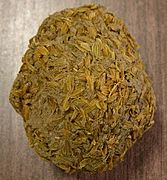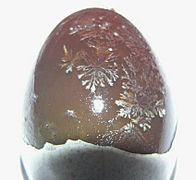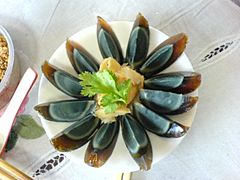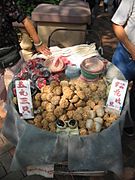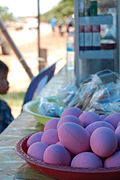Century egg facts for kids
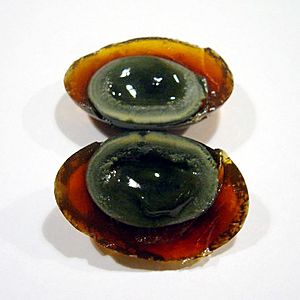
A century egg sliced open
|
|
| Alternative names | preserved egg, hundred-year egg, thousand-year egg, thousand-year-old egg, millennium egg, black egg, blacking egg, skin egg |
|---|---|
| Place of origin | Hunan, China |
| Main ingredients | Egg preserved in clay, ash, salt, quicklime, and rice hulls |
| Variations | duck, chicken or quail eggs |
Century eggs (Chinese: 皮蛋; Mandarin Pinyin: pídàn; Jyutping: pei4 daan2) are a special Chinese dish. People also call them preserved eggs, hundred-year eggs, or black eggs. They are made by preserving duck eggs, chicken eggs, or quail eggs.
The eggs are soaked in a mix of clay, ash, salt, quicklime, and rice hulls. This process takes several weeks to a few months. During this time, the eggs change a lot!
The yolk turns a dark green or grey color. It becomes creamy and has a strong, unique taste. The white changes into a dark brown, clear jelly. It also gets a salty flavor. This happens because the preserving mix makes the egg very alkaline. This chemical change breaks down parts of the egg, creating new flavors.
Sometimes, the egg white has cool patterns that look like pine branches. These are called Songhua eggs (Chinese: 松花蛋). People think these patterned eggs are even better quality. In 2014, people in China ate about 3 million tons of Songhua eggs!
Contents
History of Century Eggs
The idea of making century eggs probably started because people needed to keep eggs fresh. They would cover eggs in alkaline clay. This is similar to how some cultures in the West preserved eggs. The clay would harden around the egg. Instead of spoiling, the eggs would cure and become century eggs.
This special egg has a history of at least 400 years. One story says it was discovered about 600 years ago in Hunan, China. This was during the Ming Dynasty. A homeowner found duck eggs in a shallow pool of slaked lime. This lime was used for building his house.
He tasted the eggs and liked them. So, he decided to make more. He added salt to make them taste even better. This led to the recipe we use today. Another story tells of a young duck farmer named Shuige. He left duck eggs in a garden for a woman named Songmei. She found them later in an ash pit. The eggs had turned into century eggs. He named them "pine-patterned eggs" to honor her.
How Century Eggs Are Made
Traditional Methods
The traditional way to make century eggs has improved over time. Instead of just clay, people use a mix of wood ash, calcium oxide, and salt. This mix is put on the eggs. Adding calcium oxide and wood ash helps stop the eggs from spoiling. It also makes the process faster.
One recipe starts by boiling water with tea. Then, calcium oxide, sea salt, and ash from burned oak are mixed in. This makes a smooth paste. Each egg is carefully covered by hand. People wear gloves to protect their skin from the chemicals. Then, the eggs are rolled in rice hulls to keep them from sticking together. Finally, they are put into cloth-covered jars or baskets. The mud dries and hardens over several months. After this, the eggs are ready to eat.
Modern Methods
Today, we understand the science behind making century eggs much better. This has made the recipes simpler. Now, raw eggs can be soaked in a solution of table salt, calcium hydroxide, and sodium carbonate for about 10 days. After that, they are wrapped in plastic and aged for several weeks. This method creates the same result as the traditional way. The key is to get certain chemicals, called hydroxide and sodium ions, into the egg.
Some older methods used a harmful ingredient to speed up the process. However, zinc oxide is now the recommended and safer choice. While zinc is important for our bodies, too much can cause problems. So, the finished eggs are checked to make sure their zinc levels are safe.
Ways to Enjoy Century Eggs
Century eggs are ready to eat after you peel and rinse them. You can eat them alone or as a side dish. In some places, like Canton, people wrap pieces of century egg with slices of pickled ginger. You might even find them sold on a stick as street food!
In Shanghai, people mix chopped century eggs with cold tofu. In Taiwan, it's popular to put sliced century eggs on cold tofu with katsuobushi, soy sauce, and sesame oil. In northern China, people slice century eggs over soft tofu. They add shredded ginger and chopped spring onions. Then, they drizzle light soy sauce and sesame oil on top.
Century eggs are also used in a dish called "old-and-fresh eggs." This is where chopped century eggs are mixed with an omelette made from fresh eggs. You can also cut them into pieces and stir-fry them with vegetables, especially in Taiwanese cooking.
Many Chinese families cook century eggs with rice porridge. This dish is called "century egg and lean pork congee" (Chinese: 皮蛋瘦肉粥; pinyin: pídàn shòuròu zhōu). It's often served in dim sum restaurants. The main ingredients are rice congee, lean pork, and century egg. Sometimes, youtiao (fried dough sticks) are eaten with it. Another version adds salted duck eggs to the congee.
At special events like wedding banquets, century eggs are part of a cold dish platter. This platter might include barbecued pork, pickled baby leeks, sliced abalone, and seasoned jellyfish. This cold dish is called a lahng-poon in Cantonese.
Safety of Century Eggs
Century eggs made in traditional ways are usually safe to eat. However, sometimes there have been problems in how they are made. In 2013, some factories in Jiangxi province were found using industrial chemicals to make the eggs faster. These chemicals were not safe for food.
When this problem was discovered, officials quickly closed factories for checks. They also arrested people involved. This shows how important it is for food to be made safely. When made correctly, century eggs are a delicious and safe food to enjoy.
Images for kids
-
Century egg coated in a caustic mixture of mud and rice husk
-
Century egg showing snow-flake/pine-branch (松花, sōnghuā) patterns. These patterns are dendrites of various salts.
See also
 In Spanish: Huevo centenario para niños
In Spanish: Huevo centenario para niños


